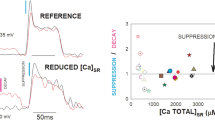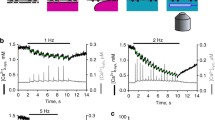Abstract
We performed experiments using the Ca2+ indicator dye, fura-2 to investigate the effect of extracellular Ca2+ concentration ([Ca2+]o) on sarcoplasmic reticulum (SR) Ca2+ release and loading in single rat ventricular cells. In normal Tyrode solution (1.8 mM [Ca2+]o) repetitive stimulation (0.5 Hz) resulted in a gradual decrease in calcium transients (the negative staircase phenomenon) without being accompanied by a gradual decrease in diastolic intracellular Ca2+ concentration. The rate of the slow decline in calcium transient was faster in lower [Ca2+]o. However, the peak of the first calcium transient was relatively invariant over a wide range of [Ca2+]o (0.5–5 mM). The size of the calcium transient elicited by field stimulation was proportional to that induced by 10 mM caffeine, applied following the field stimulation. These results suggest that the size of calcium transients depends mainly on the Ca2+ content of the SR. The quiescent period favoured the replenishment of the SR and this effect was promoted further by increasing the driving force for Ca2+ entry across the sarcolemma during this period. We conclude that in low [Ca2+]o, short stimulation interval may limit Ca2+ influx across the sarcolemma during the quiescent period to cause a gradual reduction in calcium content of the SR and thus the calcium transient.
Similar content being viewed by others
References
Aronson RS, Capasso JM (1980) Negative inotropic effect of elevated extracellular calcium in rat myocardium. J Mol Cell Cardiol 12:1305–1309
Berlin JR, Konishi M (1993) Ca2+ transients in cardiac myocytes measured with high and low affinity Ca2+ indicators. Biophys J: 65, 1632–1647
Blinks JR, Koch-Weser J (1962) Analysis of the effect of changes in rate and rhythm upon myocardial contractility. Pharmacol Rev 134:373–389
Bouchard RA, Bose D (1989) Analysis of the interval-force relationship in rat and canine ventricular myocardium. Am J Physiol 257:H2036-H2047
Capogrossi MC, Stern MD, Spurgeon HA, Lakatta EG (1988) Spontaneous Ca2+ release from the sarcoplasmic reticulum limits Ca2+-dependent twitch potentiation in individual cardiac myocytes. J Gen Physiol 91:133–155
Coulombe A, Lefevre IA, Baro I, Coraboeuf E (1989) Barium- and calcium-permeable channels open at negative membrane potentials in rat ventricular myocytes. J Membr Biol 111:57–67
Dubell WH, Houser SR (1989) Voltage and beat dependence of Ca2+ transient in feline ventricular myocytes. Am J Physiol 257:H746-H759
Endo M (1985) Calcium release from sarcoplasmic reticulum. Curr Top Membr Transp 25:181–230
Forester GV, Mainwood GW (1974) Interval dependent inotropic effects in the rat myocardium and the effect of calcium. Pflügers Arch 352:189–196
Frampton JE, Orchard CH, Boyett MR (1991) Diastolic, systolic and sarcoplasmic reticulum [Ca2+] during inotropic interventions in isolated rat myocytes. J Physiol (Lond) 437:351–375
Grynkiewicz G, Poenie M, Tsien RY (1985) A new generation of Ca2+ indicators with greatly improved fluorescence properties. J Biol Chem 260:3440–3450
Haworth RA, Griffin P, Saleh B, Goknur AB, Berkoff HA (1987) Contractile function of isolated young and adult rat heart cells. Am J Physiol 253:H1484–1491
Hilgemann DW (1986) Extracellular calcium transients and action potential configulation changes related to post-stimulatory potentiation in rabbit atrium. J Gen Physiol 87:675–706
Hoffman BF, Kelly JJ (1959) Effects of rate and rhythm on contraction of rat papillary muscle. Am J Physiol 197:1199–1204
Horiuti K, Higuchi H, Umazume Y, Konishi M, Okazaki O, Kurihara S (1988) Mechanism of action of 2,3-butanedione 2-monoxime on contraction of frog skeletal muscle fibres. J Muscle Res Cell Motil 9:156–164
Konishi M, Olson A, Hollingworth S, Baylor SM (1988) Myoplasmic binding of fura-2 investigated by steady-state fluorescence and absorbance measurements. Biophys J 54:1089–1104
Kruta V, Braveny P (1960) Potentiation of contractility in the heart muscle of the rat and some other mammals. Nature 187:327–328
Lefevre T, Coulombe A, Coraboeuf E (1994) Tonically active (background) calcium channels unmasked by phenothiazines in rat ventricular myocytes (abstract). Biophys J 66:32/a
Li T, Sperelakis N, Teneick RE, Solaro RJ (1985) Effects of diacetylmonoxime on cardiac excitation-contraction coupling. J Pharmacol Exp Ther 232:688–695
Li Q, Altschuld RA, Stokes BT (1987) Quantitation of intracellular free calcium in single adult cardiomyocytes by fura-2 fluorescence microscopy: calibration of fura-2 ratios. Biochem Biophys Res Commun 147:120–126
McDowall RJS, Munro AF, Zayat AF (1955) Sodium and cardiac muscle. J Physiol (Lond) 130:615–624
Mitchell MR, Powell T, Terrar DA, Twist VW (1984) Strontium, nifedipine and 4-aminopyridine modify the time course of the action potential in cells from rat ventricular muscle. Br J Pharmacol 81:551–556
Neher E (1989) Combined fura-2 and patch clamp measurement in rat peritoneal mast cells. In: Sellin LC, Libelius R, Thesleff S (eds) Neuromuscular junction. Elsevier, Amsterdam, pp 65–76
O'Neill SC, Donoso P, Eisner DA (1990) The role of [Ca2+]i and [Ca2+] sensitization in the caffeine contracture of rat myocytes: measurement of [Ca2+]i and [Caffeine]i. J. Physiol (Lond) 425:55–70
Reuter H (1974) Localization of beta adrenergic receptors, and effects of noradrenaline and cyclic nucleotides on action potentials, ionic currents and tension in mammalian cardiac muscle. J Physiol (Lond) 242:429–451
Schouten VJA (1990) Interval dependence of force and twitch duration in rat heart explained be Ca2+ pump inactivation in sarcoplasmic reticulum. J Physiol (Lond) 431:427–444
Shattock MJ, Bers DM (1989) Rat vs. rabbit ventricle: Ca flux and intracellular Na assessed by ion-selective microelectrodes. Am J Physiol 256:C813-C822
Smith GL, Valdeolmillos M, Eisner DA, Allen DG (1988) Effects of rapid application of caffeine on intracellular calcium concentration in ferret papillary muscles. J Gen Physiol 92:351–368
Spurgeon HA, Isenberg G, Talo A, Stern MD, Capogrossi MC, Lakatta EG (1988) Negative staircase in cytosolic Ca2+ in rat myocytes is modulated by depolarization duration (abstract). Biophys J 53:601a
Spurgeon HA, Stern MD, Baartz G, Raffaeli S, Hansford RG, Talo A, Lakatta EG, Capogrossi MC (1990) Simultaneous measurement of Ca2+, contraction, and potential in cardiac myocytes. Am J Physiol 258:H574-H586
Tada M, Katz AM (1982) Phosphorylation of the sarcoplasmic reticulum and sarcolemma. Annu Rev Physiol 44:401–423
Author information
Authors and Affiliations
Rights and permissions
About this article
Cite this article
Suda, N., Kokubun, S. The effect of extracellular Ca2+ concentration on the negative staircase of Ca2+ transient in field-stimulated rat ventricular cells. Pflugers Arch. 429, 7–13 (1994). https://doi.org/10.1007/BF02584024
Received:
Revised:
Accepted:
Issue Date:
DOI: https://doi.org/10.1007/BF02584024




